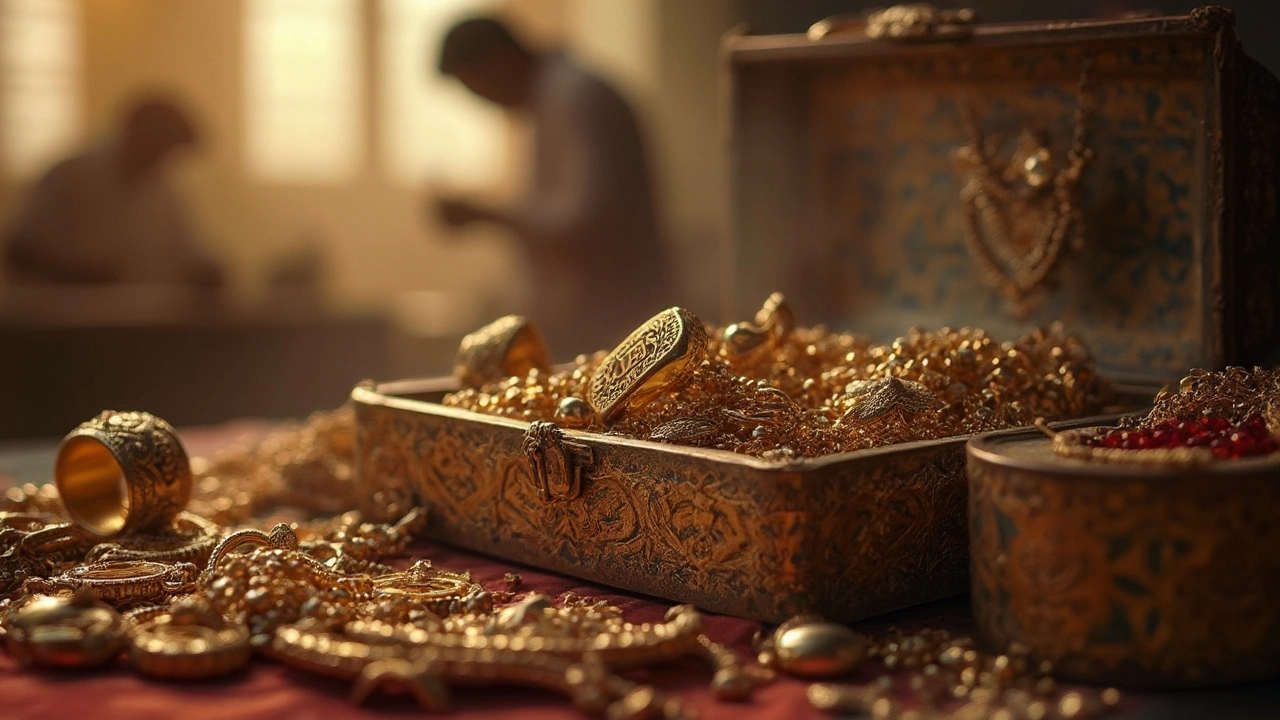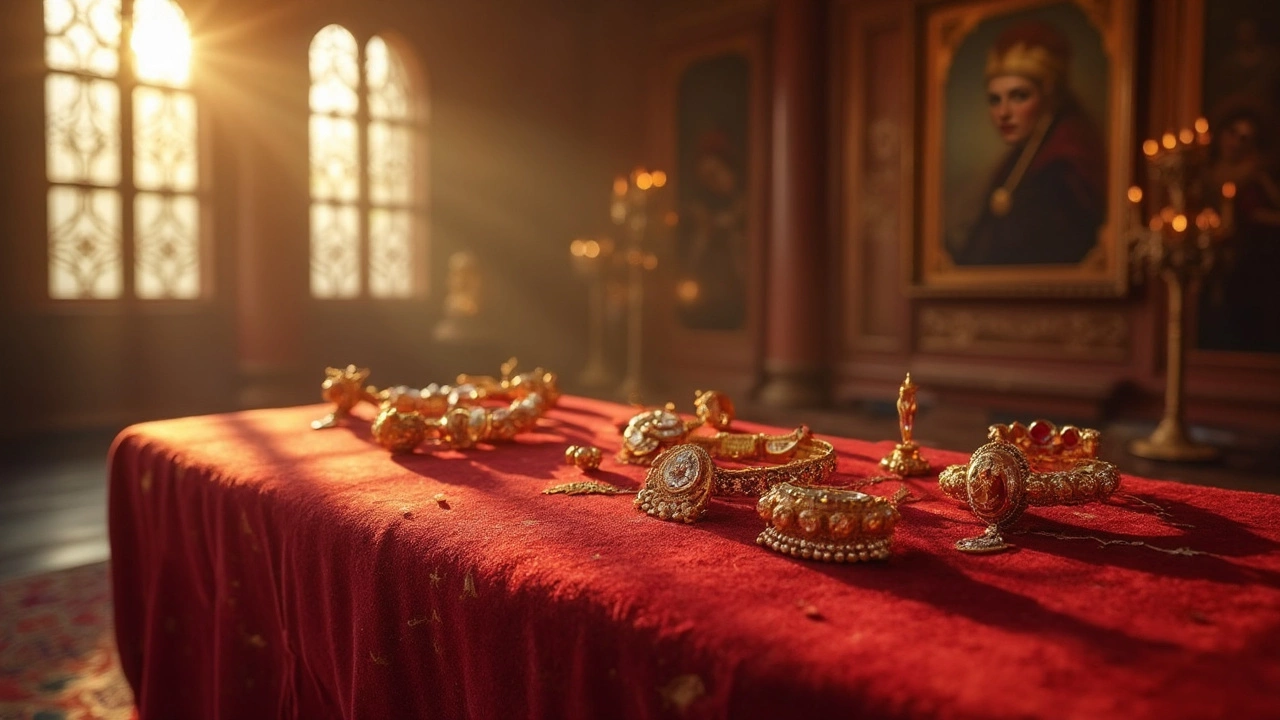
Ever glanced at a piece of jewelry and noticed those tiny 'KK' letters stamped into the metal? You're not alone. These small letters can unlock a wealth of history and value in your antique finds. In many cases, 'KK' represents a hallmark or maker's mark—a signature from the jeweler or manufacturer responsible for crafting the piece. These marks are kind of like a fingerprint for jewelry, pointing to its origins and sometimes even its age.
But what does 'KK' actually stand for? It could be the initials of the jeweler or a name abbreviation of a historic jewelry house. Knowing this can totally change how you see a piece, turning it from a simple accessory into a connection with history. Keep in mind, marks like 'KK' can be crucial in confirming the authenticity of a piece, especially in the ever-intriguing world of antique jewelry where reproductions abound.
And here's a tip: when you find a piece with this mysterious marking, do a bit of digging. Researching could reveal whether you've stumbled upon something rare or unique—something with a story worth telling. For collectors, these insights not only make for good conversation but can also significantly boost the piece's value.
- Decoding Jewelry Marks
- The Origin of KK
- Identifying Authentic Pieces
- Tips for Jewelry Enthusiasts
- Caring for Antique Jewelry
Decoding Jewelry Marks
So, you're staring at those tiny symbols on your jewelry, and you're thinking, "What do these mean?" You're in the right place. Jewelry marks are essential for anyone looking to understand the history or value of a piece. They act like the piece's CV—a summary of its origin, creator, and sometimes its metal quality.
Understanding Hallmarks
First off, let's talk about hallmarks. These are official marks struck into the jewelry that tells you its metal content and quality. Common metals you might spot include gold, silver, and platinum, each having unique marks. So, if you come across a hallmark stating it's 925, that's silver, while 750 means you've got some high-quality gold.
The Role of Maker's Marks
Then there are maker's marks, like the elusive 'KK'. These initials are like a signature from the jeweler or company who made the piece. Capturing this could be super exciting for a collector since it connects the jewelry to its creator, adding a touch of personal history. For example, in Finland, 'KK' can point to the Finland-based jewelry craftsman Kultaseppä J.K. Kärkkäinen.
Navigating Authenticity
If you're diving into the antique jewelry world, knowing these marks boosts your skill in spotting fakes. A lot of reproductions miss these subtleties, so sharpening your eye can save you some hard cash. Fakes might have the look but real hallmarks and maker’s marks back that up with evidence engraved on the piece itself.
Quick Tips for Spotting Marks
- Keep a loupe handy—a small magnifying glass to zoom in on those marks.
- Research online databases or jewelry books which list known hallmarks and maker's marks.
- Compare with other pieces you know to be authentic to spot inconsistencies.
Understanding these marks isn't just for collectors. It's for anyone curious about the story and value behind their bling. Next time you see 'KK', you're not just seeing letters—you're seeing a chapter of history, waiting to be explored.
The Origin of KK
The letters KK on a piece of jewelry aren't just random marks. They're often steeped in a rich history. In the world of antique jewelry designs, such marks are known as 'maker's marks' or hallmarks. These marks can tell you loads about where a piece comes from or who made it.
One known origin of the KK jewelry mark traces back to Scandinavian regions, particularly Finland. A famous example is the mark used by renowned Finnish jeweler, Kultaseppä Kallio, whose initials are KK. Established in the early 20th century, his workshop became known for crafting pieces that embodied Finnish design—a lovely blend of elegance and simplicity.
But Finland isn't the only place to find KK jewelry marks. Across Europe, several jewelers and workshops who shared those initials proudly stamped their creations with KK. This use was not only a stamp of craftsmanship but also a claim to authenticity and a defense against the burgeoning world of counterfeits.
Although it's less common, you might stumble upon KK in the United States as well. In the mid-20th century, Kenneth Kole Jewelry, based in New York, often used KK as their maker's mark. Their pieces were characterized by intricate designs catering to the then-fashion-forward clientele.
So, the next time you see a little KK engraved on a ring or brooch, you're potentially holding a piece of history. While it might take a bit of sleuthing, uncovering the story behind these marks can transform your admiration into a deeper appreciation for not just the aesthetic but the legacy of the piece.

Identifying Authentic Pieces
So you've got your hands on a piece of jewelry with a 'KK' mark, and you're wondering how to confirm if it's the real deal. Identifying authentic antique jewelry designs isn't just for the experts. With a keen eye and some basic tools, anyone can learn the tricks to spot genuine items.
Look for Hallmarks and Maker’s Marks
Start with the hallmarks. These tiny symbols or initials are engraved on the jewelry, often in a hidden spot like the inside of a ring band or on the clasp of a bracelet. For a piece stamped with 'KK,' knowing the origin of these initials is crucial.
One key tip is to research your mark in jewelry books or online databases. Maker's marks can connect your jewelry to specific eras or craftspeople. Don't underestimate these—it’s like finding the jeweler's signature.
Check the Materials
The materials used can also offer clues. Authentic antique pieces often make use of high-quality metals such as gold, silver, or platinum. Take the piece to a trusted jeweler for testing if you're in doubt. This can confirm the metal's authenticity and help date the piece, connecting to the correct 'KK' craftsman or jeweler.
Assess Craftsmanship
Examine the piece's craftsmanship. Look for signs of hand-crafting, like uneven patterns or little imperfections; these often signal older, handmade jewelry. Modern machine-made items usually exhibit near-perfect symmetry.
Get an Appraisal
When in doubt, consult with a professional appraiser who specializes in antiques. They can provide insight into the piece's history and value, helping you understand if your jewelry marking connects to a coveted historical period or a renowned jeweler.
It's worth mentioning that less than one-third of all antique jewelry pieces have known origins. Like detectives, collectors and enthusiasts solve these mysteries by combining research with expert guidance. So, examine your piece thoroughly and don’t hesitate to lean on experts when needed.
Tips for Jewelry Enthusiasts
If you're diving into the sparkling world of antique jewelry, you'll want to do it right. Especially if you're spotting hallmarks like KK, which might hint at something special. So, how do you know you're getting your hands on a true piece of history, and not just a pretty replica?
1. Learn to Identify Marks
Start by familiarizing yourself with common jewelry markings and hallmarks. Books and online resources can be treasure troves of info, helping you decipher what those tiny engravings might mean. Knowing the difference between a genuine mark and a fake one is key.
- KK jewelry marks might trace back to specific jewelers, enhancing the piece's value.
- Look for other stamps such as purity marks – 925 for sterling silver, for example.
2. Develop an Eye for Craftsmanship
Quality craftsmanship is usually a good sign of genuine antique jewelry. Pay attention to details like the setting and the cut of the gemstones. High-quality pieces often have meticulous detailing.
3. Verify the Source
When you find what seems to be a remarkable piece, trace its history if possible. Reputable sellers should provide information about a piece's origin, especially if it claims to be antique. Ask questions – the more you know, the less likely you are to be duped.
4. Protect Your Investment
Caring for antique or antique jewelry designs is crucial. Avoid harsh chemicals, store pieces separately to prevent scratches, and consider getting them professionally cleaned by someone experienced with antiques.
5. Know When to Spend
If you're making a substantial purchase, especially an item marked with KK, it might be wise to get an appraisal. It not only offers peace of mind but can be invaluable for insurance purposes.
Remember, collecting antique jewelry is as much about passion as it is about prudence. The more you learn, the more rewarding your journey will be. Keep an eye out for those intriguing little details – they just might lead to your next great find!

Caring for Antique Jewelry
Got a piece of old jewelry with 'KK' or any other unique hallmark? Keeping your antique jewelry in top shape requires a bit of extra love and attention. These pieces can be delicate, so it's important to know how to keep them looking their best. Let’s break down the essentials.
Gentle Cleaning is Key
Start with cleaning, but go easy. Avoid harsh chemicals or cleaners; they can harm delicate materials. Instead, use a soft, damp cloth to gently wipe away dust and dirt. If it needs a deeper clean, consider a mix of mild dish soap and water. Remember, it’s all about being gentle.
Proper Storage
Just tossing your jewelry into a drawer? Not a good move. Store each piece separately in a soft pouch or a lined jewelry box to prevent scratches and tangles. If you’ve got something really valuable, think about investing in a box with a lock for added security.
Regular Inspections
Every now and then, take a closer look at your jewelry. Check for any loose stones or weak clasps. Catching these early can save you from losing a piece down the line. For significant issues, it’s best to let a professional handle repairs—don’t DIY if you’re unsure.
Mind the Moisture
Moisture is not your old jewelry's friend. Try to keep things dry. That means taking off rings before washing hands and keeping more sensitive pieces away from humid environments like bathrooms.
- Avoid wearing jewelry while swimming or in the shower.
- Consider silica gel packets for your storage to absorb excess moisture.
Professional Care
If you're unsure or nervous about cleaning or handling your antique jewelry, getting it checked by a professional jeweler isn’t a bad idea. They can provide specialized cleaning and maintenance advice to keep your pieces in excellent condition.
Safeguarding your precious antique jewelry not only preserves its beauty but also maintains its value, letting you enjoy the charm of history while keeping it ready for future generations.


